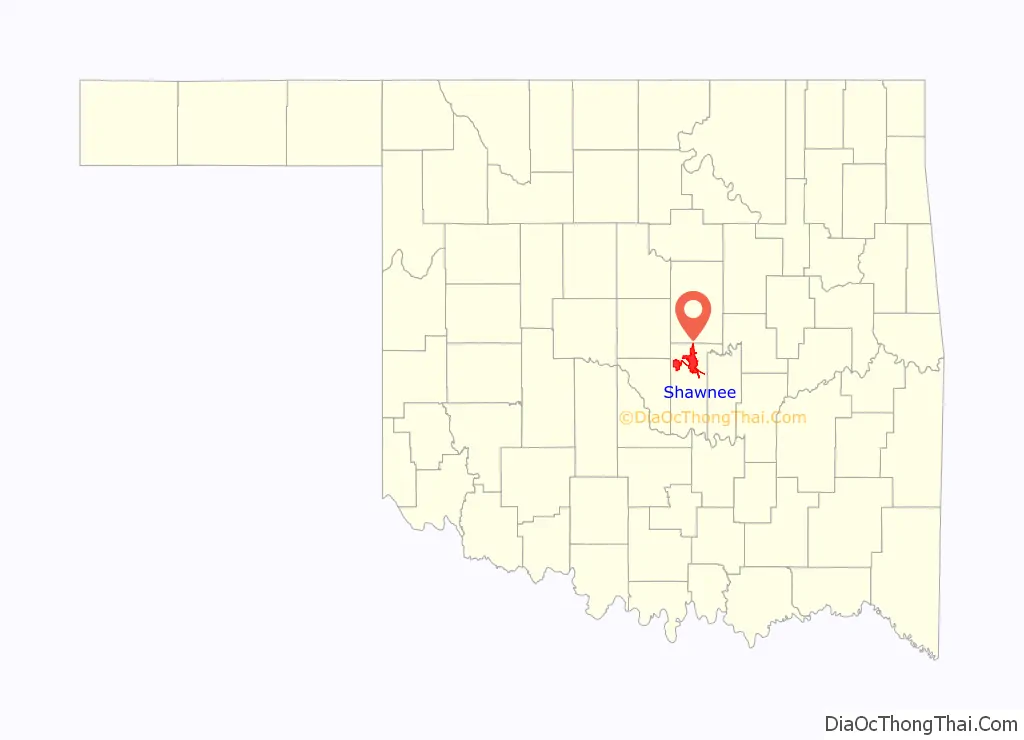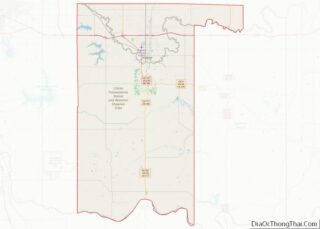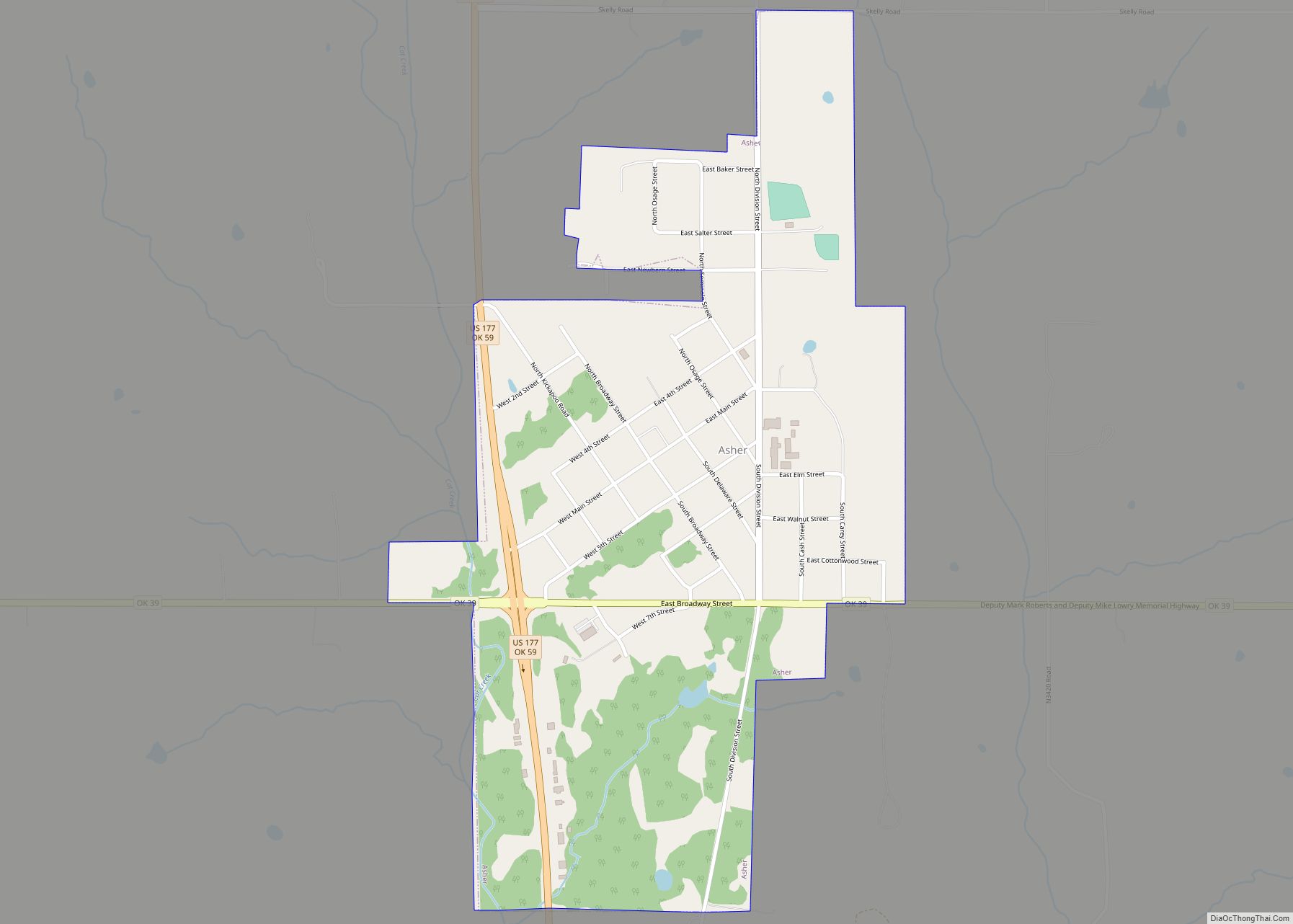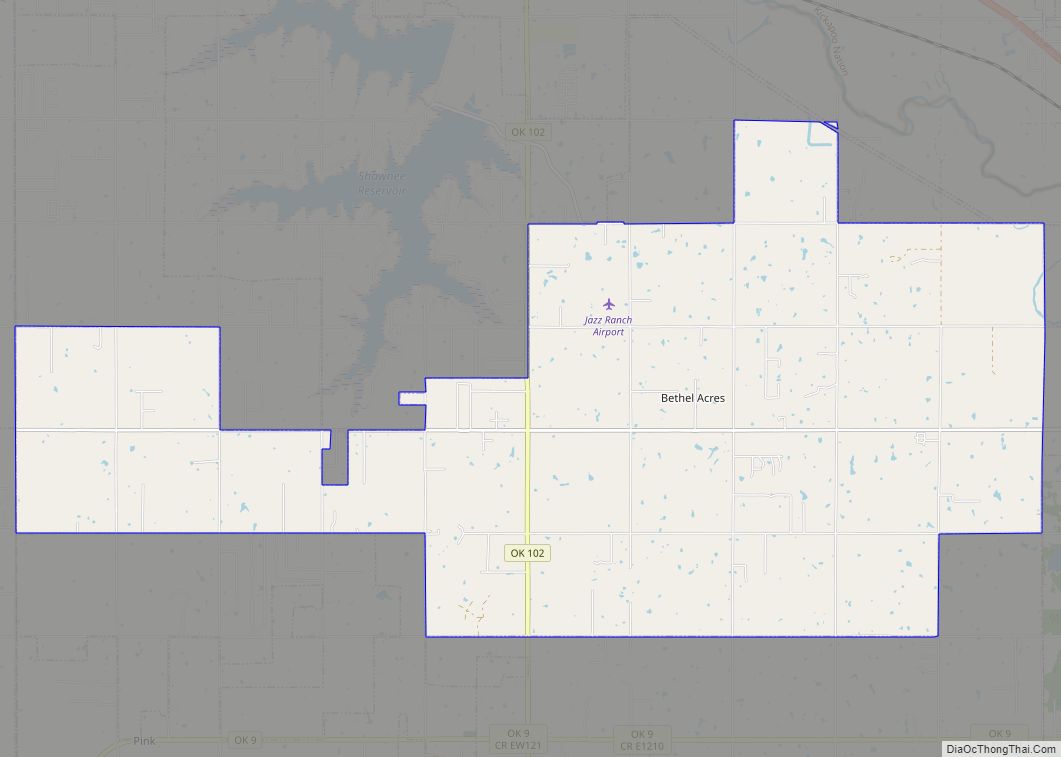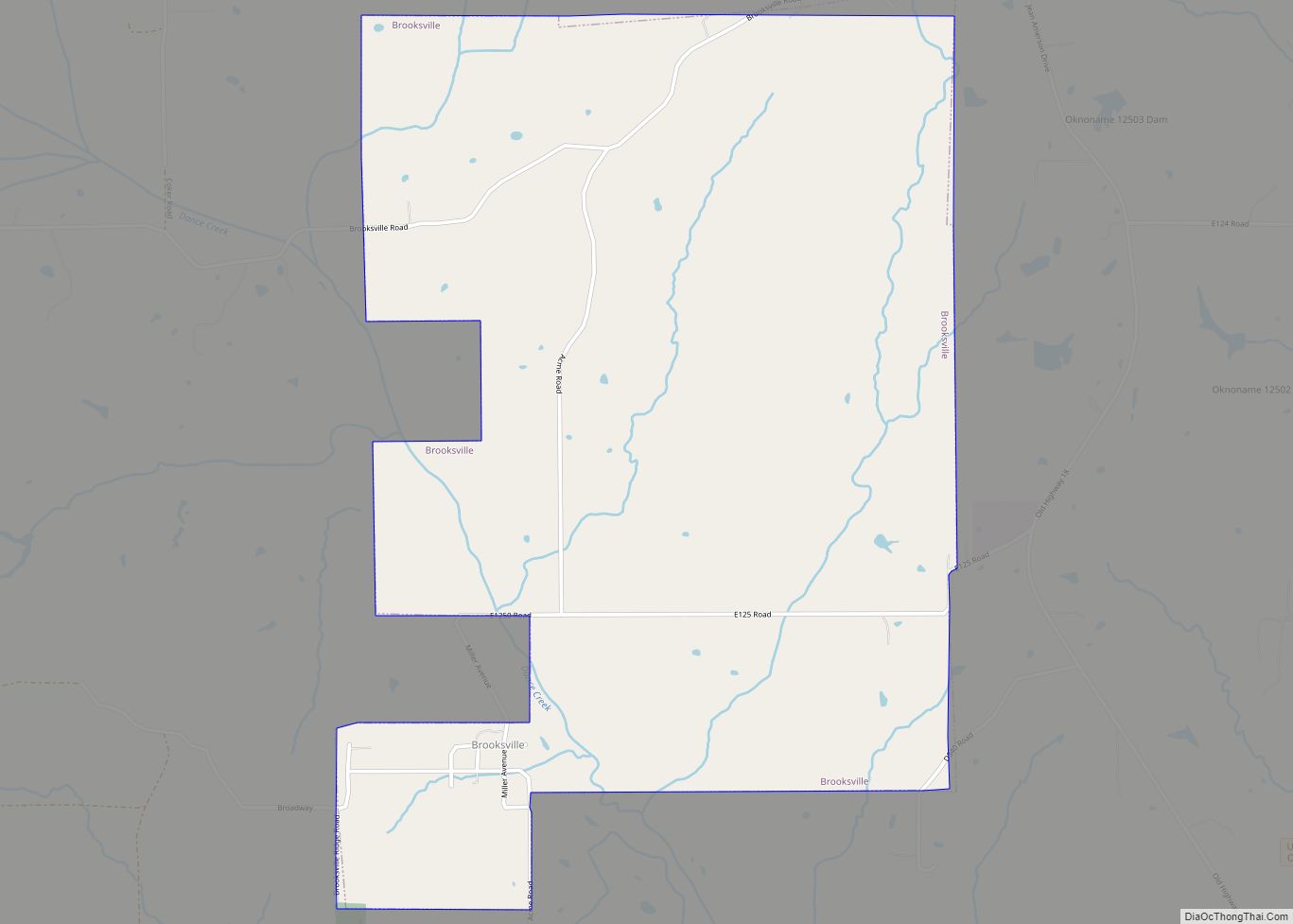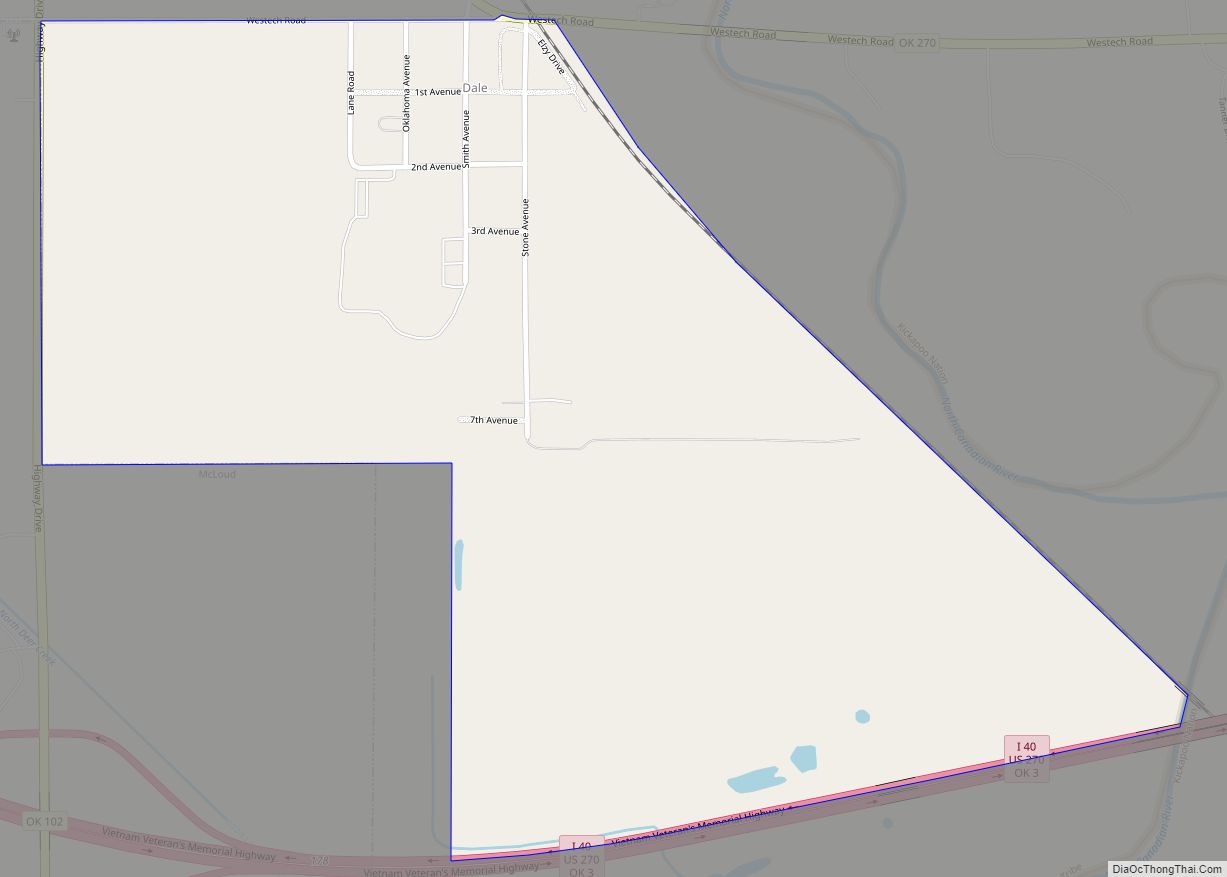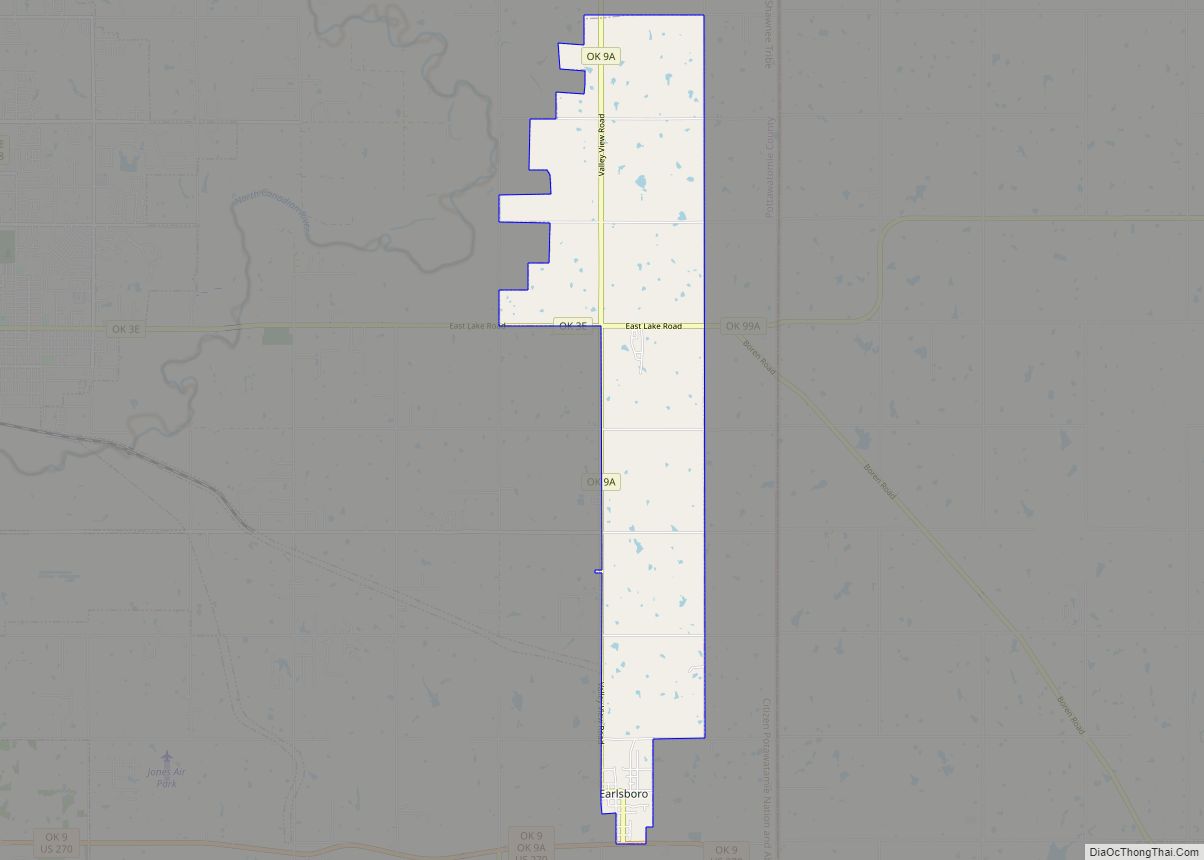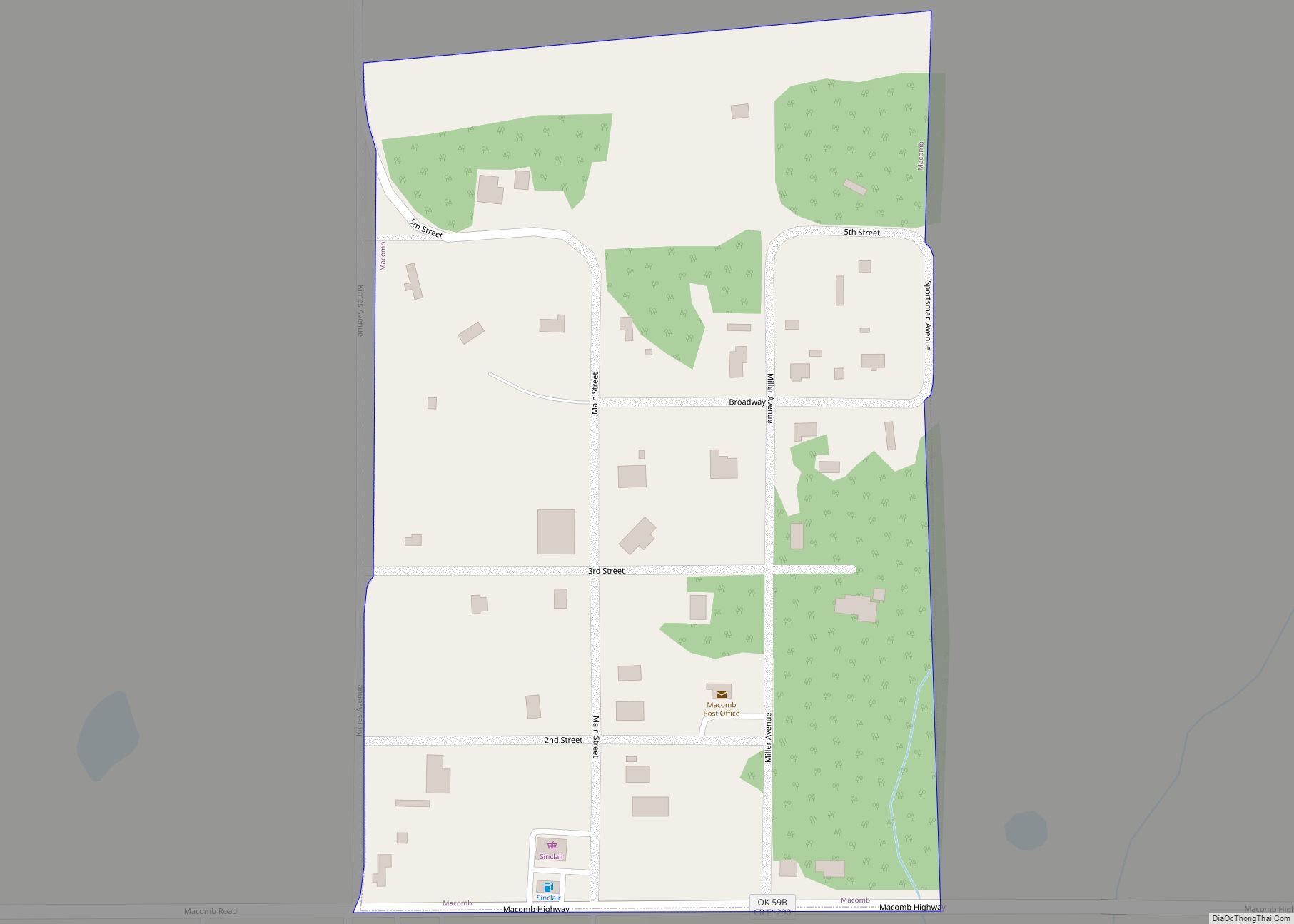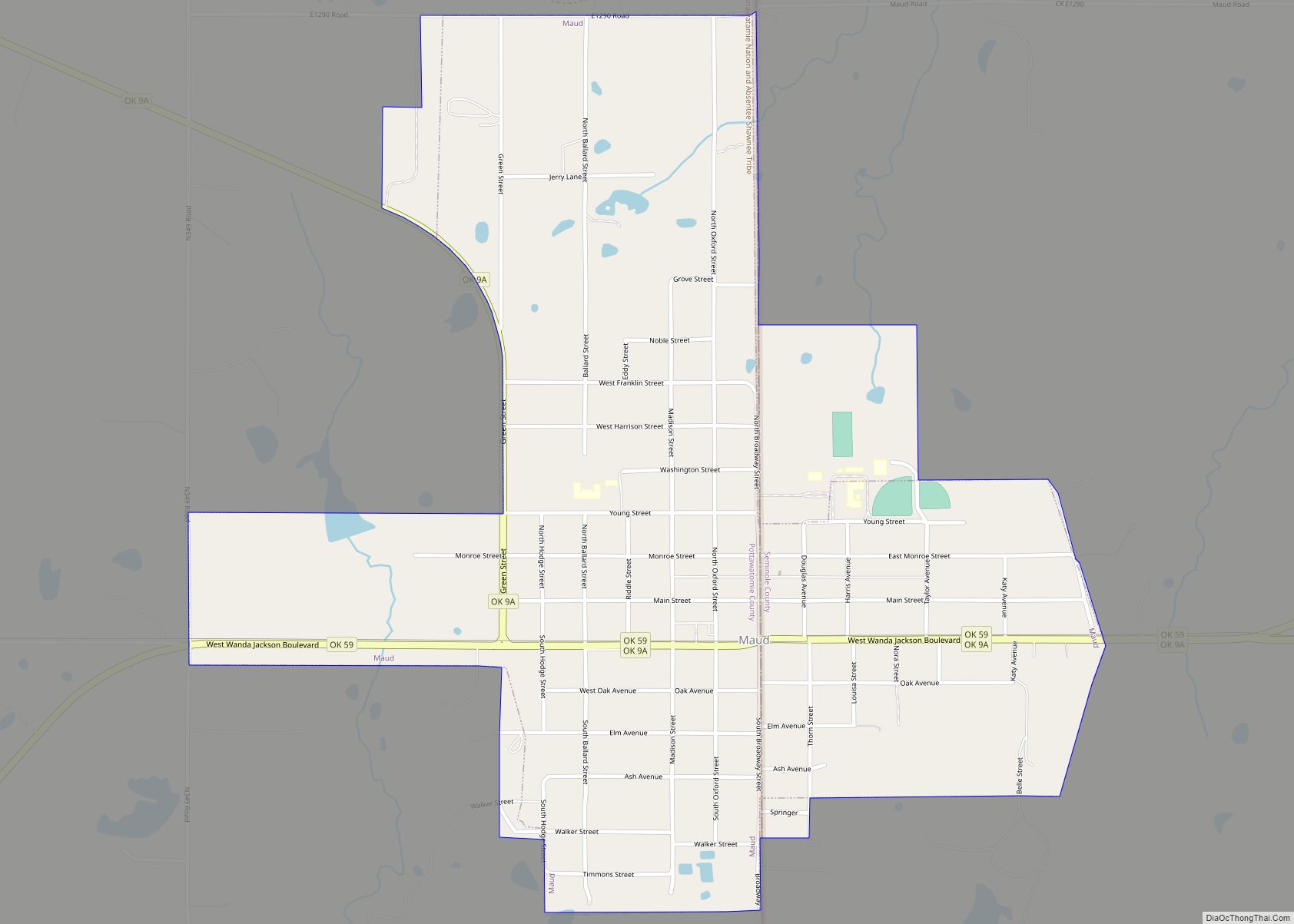Shawnee (Meskwaki: Shânîheki) is a city in and the county seat of Pottawatomie County, Oklahoma, United States. The population was 29,857 in 2010, a 4.9 percent increase from the figure of 28,692 in 2000. The city is part of the Oklahoma City-Shawnee Combined Statistical Area and the principal city of the Shawnee Micropolitan Statistical Area.
With access to Interstate 40, Shawnee is approximately 45 minutes east of downtown Oklahoma City. To the east and northeast, Shawnee is 112 miles from the McClellan-Kerr Arkansas River Navigation System, which provides shipping barge access to the Gulf of Mexico.
| Name: | Shawnee city |
|---|---|
| LSAD Code: | 25 |
| LSAD Description: | city (suffix) |
| State: | Oklahoma |
| County: | Pottawatomie County |
| Elevation: | 1,060 ft (323 m) |
| Total Area: | 40.91 sq mi (105.95 km²) |
| Land Area: | 38.61 sq mi (99.99 km²) |
| Water Area: | 2.30 sq mi (5.96 km²) |
| Total Population: | 31,377 |
| Population Density: | 812.75/sq mi (313.81/km²) |
| ZIP code: | 74801, 74802, 74804 |
| Area code: | 405/572 |
| FIPS code: | 4066800 |
| GNISfeature ID: | 1097964 |
| Website: | ShawneeOK.org |
Online Interactive Map
Click on ![]() to view map in "full screen" mode.
to view map in "full screen" mode.
Shawnee location map. Where is Shawnee city?
History
The area surrounding Shawnee was settled after the American Civil War by a number of tribes that the federal government had removed to Indian Territory. The Sac and Fox originally were deeded land in the immediate area but were soon followed by the Kickapoo, Shawnee, and Potawatomi Indians. These federally recognized tribes continue to reside today in and around Shawnee.
Over the course of the 1870s, Texas cattle drovers pushed their herds across Indian Territory; there were four major trails, with the West Shawnee trail crossing near present-day Kickapoo and Main streets. With the cattle drives, railroads were constructed through the territory, with the government forcing tribes to cede rights of way.
In addition, white settlers pressed for more land; they were encroaching on territories previously reserved by treaty to Native Americans. In 1871 a Quaker mission was established here. (The current Mission Hill Hospital is located near that site, now occupied by an historic building.) That first missionary, Joseph Newsom, opened a school in 1872. By 1876 a post office and trading post had been established a quarter mile west of the mission at what became known as Shawnee Town.
Beginning in April 1889, the United States government succumbed to the pressure that had built to open the tribal lands to white settlement. It was also making policy to encourage Native Americans to assimilate into white society. By allocating communal lands to individual households and extinguishing tribal land claims, Congress was preparing the territory for eventual statehood. The end of communal holdings was also intended to be the end of traditional tribal government, to be replaced with leaders appointed by the federal government.
The Dawes Act allocated the tribes’ communal lands into 160-acre plots to individual tribal members believing it would support a family farm. Tribal members were registered with records known as the Dawes Rolls established for each tribe. The government declared that tribal land in excess of what was allocated to member households was “surplus” and available for settlement by non-Native Americans. It allocated that surplus land through land runs, essentially races by which people staked claims on land. Some tribes lost parts of their communal lands, disrupting traditional governments and practices.
The first land run took place in the central area of Oklahoma Territory in 1889 known as the Unassigned Land. In the Land Run of 1891 onto surplus land of the Sac and Fox, Citizen Pottawatomie and Shawnee, just east of the original run, was opened for settlement. Prospective land owners lined up along the Kickapoo Tribe’s border and Etta B. Ray was the first to dash across the line into the area designated County B. Her claim and those of John Beard, James T. Farrall, and Elijah A. Alley were to become the city of Shawnee. Etta Ray married Henry Beard, an Oklahoma City business owner, a month after the run and they came to her claim to live in the cabin that she and her family had built for them. Several names were proposed for the new city, including Brockway, Forest City and Shawneetown, after the store that was south of the townsite. Following a long discussion among early settlers who had their own ideas for the town’s name, a compromise was reached. They named the town Shawnee after the tribe that had been living there. A second run, onto the Kickapoo Land to the west of the original, was held in 1895, adding more acreage added to Pottawatomie County
In the early spring of 1895, Mr. Beard entered into an agreement with the promoters of the Choctaw, Oklahoma and Gulf Railroad (CO&G), then extending its line from Memphis, Tennessee, to Amarillo, Texas, to build through the land his wife had claimed. In consideration he gave the railway company one-half of the claim of one hundred and sixty acres. The road was built through his farm, and the City of Shawnee was founded on July 4, 1895.
For the first few years of the new century, Shawnee was undergoing a boom that came close to keeping pace with that of Oklahoma City. Located in the heart of cotton, potato, and peach country, Shawnee quickly became an agricultural center. By 1902, there were seven cotton gins in the immediate area and two cotton compresses. Between March 1901 and March 1902, 375 railroad cars of cotton product were shipped out of Shawnee, along with 150,000 bales of cotton. Feed stores, wagon yards, an overall factory, and an assortment of other businesses designed to serve the farmers as they brought their crops to market arose in Shawnee.
The population grew from 250 to 2,500 from 1892 to 1896. In 1896, the Tecumseh Railway was built from Shawnee to Tecumseh, being then the county seat; and, under later CO&G ownership, the line was extended to Asher in 1902. In 1903-1904 the Atchison, Topeka and Santa Fe Railway and the Missouri, Kansas and Texas Railway extended service to town, after being given land inducements from Henry Beard and James Farrall. Shawnee was an intended destination from Webbers Falls, Oklahoma, of the Webbers Falls, Shawnee and Western Railroad from 1911, but that line never got further west than Warner, Oklahoma.
Oklahoma Baptist University opened in 1910. Its first building, Shawnee Hall, was a gift from the citizens. St. Gregory’s College (later St. Gregory’s University) relocated to Shawnee from Sacred Heart in 1915, where it had been associated with a Catholic mission and school.
On the evening of May 19, 2013, a violent EF4 tornado hit the town resulting in two deaths.
The town was struck by two high-end EF2 tornadoes in the first four months of 2023. The first one occurred on the north side of the city on February 26, although the most severe damage occurred in nearby town of Aydelotte. Both communities would be struck again on April 19 with Shawnee being struck directly. Major damage was inflicted to numerous structures, including the high school, and at the Oklahoma Baptist University campus.
Historic Downtown
Downtown Shawnee is an excellent example of many Main Street communities that emerged in the late 19th century as part of the westward movement. Choosing not to organize its activity around a central square, as did many towns in New England, the South, and upper-Midwest, Shawnee represents a distinctly western model of urban development. Depending on railroad lines for its economic health, Shawnee’s Main Street became the focal point for commercial, manufacturing, and entertainment activity beginning in 1895, four years after the region was opened for European-American settlement when authorities staged a land run.
Competing with Oklahoma City as the hub of central Oklahoma, Shawnee developed a broad base of economic activity. As late as 1910, city leaders hoped that one more rail line, a meat packing plant, and the state capital might be just enough to surge ahead of its rival 30 miles to the west. However, Shawnee came in third in the statewide election to determine the capital. It lost both the railway and the meatpacking plant to Oklahoma City. The setbacks resulted in Shawnee being a small city built with services and retail developed around the activity of Main Street.
The railroad industry led the early strength of the economy. The Santa Fe Train Depot (still extant), with its unique architecture, serves as a visible reminder of the city’s dependence on the train. During the early 20th century, the Rock Island Railroad and the Missouri-Kansas-Texas Railroad both had depots in the city. Shawnee’s major employer was the Rock Island Railroad, which had located its main southwestern repair shops in the city in 1896. After nearly 40 years, the railroad moved its shops to El Reno in 1937, but two major buildings remain. The Santa Fe Railroad also had repair shops just south of the city. By 2000 only a large concrete tower remained, and it was demolished that year. Some of the roundhouse buildings are now used by the city for storage and technical repair.
Serving as the region’s agricultural hub during much of the first quarter of the 20th century, Shawnee provided the market for farmers to sell their crops. Cotton was a major crop and Main Street was often lined with bales; mule sellers, peanut vendors, and peach growers. The building reputed to be the largest cottonseed oil mill in the Southwest is still extant; this same building later was adapted as a peanut factory to process another commodity crop. The Shawnee Flouring Mill, long integral to the city, still dominates the skyline of downtown.
The buildup of industry and the armed forces for the Second World War, and in particular the construction of Tinker Air Force Base east of Oklahoma City, benefited Shawnee’s economy. At various times, Tinker has employed as many as 3,000 Shawnee residents. After the war, three major manufacturing concerns were important to Shawnee’s economy. Jonco, Inc., manufactured aviation products and employed nearly 1,000 in 1958. The Sylvania Corporation produced vacuum tubes and electrical parts in its Shawnee plant and employed another 1,000. The Shawnee Milling Company, which had rebuilt after fires in 1934 and 1954, employs nearly 300 workers.
Also continuing as a nationally known company which began in 1909 is Round House Overalls. Recognized as the oldest operating manufacturing company in the state turns out more than 300,000 denim products shipped all over the world. Alvin S. Nucholls established the factory to meet the needs of the overwhelming population working for the railroads in the early days of Shawnee. The Antosh family has owned the company since 1964.
Sonic, a well-known drive-in fast food chain, originated in Shawnee. The 3000th Sonic Drive-In is also in Shawnee. Troy N. Smith, Sr. and Joe McKimmey owned the Log House Restaurant and a drive-up root beer stand called the Top Hat. In 1959 Smith and McKimmey went their separate ways and Smith opened a hamburger drive-in down Harrison Street installing a “call-in” system rather than the carhops. He dubbed his drive-in the Sonic. Both places were in existence until a fire in the Top Hat in the mid-1960s forced closure. McKimmey built the Log House Restaurant into a popular steak house and Smith sold franchises to the Sonic and has since expanded into a national drive-in food chain with now over 3,500 establishments.
Beginning in the 1970s, Shawnee’s economy improved with the addition of a number of industrial plants, including Eaton Corp. and TDK north of the city; they added approximately 1,000 jobs to the community base.
In 1980 Main Street was dominated by small retail establishments in which 80 percent are housed in buildings built prior to statehood in 1907. The majority of these buildings have had their façades altered to adjust to the changing tastes in the 20th century although one block (between Philadelphia and Union streets) remains substantially unaltered reminding of how life on Main Street functioned prior to statehood.
One block west at Broadway and Main the building originally constructed as The Mammoth Department Store, has been altered very little. The building once housed Montgomery Ward and is now Neal’s Home Furnishings. Before World War II, Main Street also had numerous drugstores and soda fountains serving as gathering places for young people. Today, Owl Drug, in a building operated as a drugstore since 1895, retains many old fixtures and appears much as it did during the 20th century.
Shawnee’s first sky scraper, the Hilton Phillips Hotel, later known as the Aldridge, was built in 1928 at the peak of the wealth and growth generated by the oil boom of the 1920s. This stimulated development of the four-story Masonic Temple Office Building, constructed in 1929 across the 9th street from the Aldridge.
Main Street had a number of entertainment facilities. A convention hall attracted well-known celebrities of the 1910s and 1920s, such as Sarah Bernhardt but was razed by 1930 for a bus company barn. An opera house on Market and Main was the site of many memorable events. The early movies theaters are now gone except the Ritz Theater, which was the oldest continuously operating theater in Oklahoma until the theater’s closure in 1989. It continues to be used for “live shows.” The Bison Theater building remains but after being used as an antique shop it’s now empty. Downtown Shawnee has lost many buildings of historical value, but still retains a significant number of resources. These provide a living reminder of the retail and human scale of Main Street in the late 19th and early 20th centuries.
Santa Fe Depot
Located at 614 E. Main in Shawnee is a unique railroad depot made of limestone blocks two to three-feet deep. With a 60 ft. turret, it takes on the slight appearance of a castle, contrasting with the surrounding architecture. It was built in 1902 and was placed on the National Register of Historic Places in 1974. After operations of the Santa Fe Railroad ceased in 1971 the City of Shawnee took over the depot property. It was assigned to the Pottawatomie County Historical Society which began restoration of this depot in 1979, after it had stood vacant for two decades. The building was remodeled into a railroad and historical museum, which opened on May 30, 1982. It contains numerous local artifacts from the settlement of Shawnee, as well as railroad memorabilia and a gift shop. The Board of Directors is currently erecting a new building directly north of the old depot. The 100+ year old depot will then house railroad artifacts while other items will be displayed in the new area.
Benson Park
Located midway between Shawnee and Tecumseh, Benson Park served the recreational needs of Shawnee residents for about 20 years. It had a stop on the interurban streetcar that ran between the two towns to the park. Built by the railroad to encourage citizens to travel by rail it opened in 1907. The park had a lake for boating, an opera house, skating rink, roller coaster, large picnic areas and later a swimming pool known as The Plunge. The arrival of automobiles which most families could then afford plus the financial distress in the late ’20s forced closure soon after 1930 although the pool and the picnic areas were still briefly in use. As of 2016, the space that was once the park is on private property and occupied by a large pecan orchard.
Pottawatomie County Seat dispute
In 1907 Oklahoma was admitted as a state and 8,024 people voted that the county seat be moved to Shawnee while 5,027 wanted it to remain in Tecumseh. The case was appealed and the higher courts decided bribery might have figured into the election since Shawnee had offered use of property in Woodland Park as a site for the county court house. In 1911, the people of Pottawatomie County again voted to keep the county seat at Tecumseh, by a vote of 7,749 to 5,927.
In October 1930 some 6,700 signatures were collected on a petition to ask Governor William J. Holloway for a referendum on the site of the county seat. A special election was held December 18, and 12,800 voters, a record number, went to the polls. Shawnee won the necessary two-thirds majority by a 90-vote margin. A recount cut this to 11. Tecumseh filed suit, alleging election fraud relating to a $35,000 slush fund, Shawnee supporters providing liquor at the polls, college boys being allowed to vote, etc. The Supreme Court favored Shawnee.
Until the mid-1930s, county officers contracted business in downtown Shawnee buildings. President Franklin D. Roosevelt’s New Deal helped fund construction of a new county courthouse in Shawnee which was built in Woodland Park. On July 6, 1935, Governor E.W. Marland dedicated the new building.
Shawnee Road Map
Shawnee city Satellite Map
Geography
According to the United States Census Bureau, the city has a total area of 44.7 square miles (116 km), of which 42.3 square miles (110 km) is land and 2.4 square miles (6.2 km) (5.37%) is water.
See also
Map of Oklahoma State and its subdivision:- Adair
- Alfalfa
- Atoka
- Beaver
- Beckham
- Blaine
- Bryan
- Caddo
- Canadian
- Carter
- Cherokee
- Choctaw
- Cimarron
- Cleveland
- Coal
- Comanche
- Cotton
- Craig
- Creek
- Custer
- Delaware
- Dewey
- Ellis
- Garfield
- Garvin
- Grady
- Grant
- Greer
- Harmon
- Harper
- Haskell
- Hughes
- Jackson
- Jefferson
- Johnston
- Kay
- Kingfisher
- Kiowa
- Latimer
- Le Flore
- Lincoln
- Logan
- Love
- Major
- Marshall
- Mayes
- McClain
- McCurtain
- McIntosh
- Murray
- Muskogee
- Noble
- Nowata
- Okfuskee
- Oklahoma
- Okmulgee
- Osage
- Ottawa
- Pawnee
- Payne
- Pittsburg
- Pontotoc
- Pottawatomie
- Pushmataha
- Roger Mills
- Rogers
- Seminole
- Sequoyah
- Stephens
- Texas
- Tillman
- Tulsa
- Wagoner
- Washington
- Washita
- Woods
- Woodward
- Alabama
- Alaska
- Arizona
- Arkansas
- California
- Colorado
- Connecticut
- Delaware
- District of Columbia
- Florida
- Georgia
- Hawaii
- Idaho
- Illinois
- Indiana
- Iowa
- Kansas
- Kentucky
- Louisiana
- Maine
- Maryland
- Massachusetts
- Michigan
- Minnesota
- Mississippi
- Missouri
- Montana
- Nebraska
- Nevada
- New Hampshire
- New Jersey
- New Mexico
- New York
- North Carolina
- North Dakota
- Ohio
- Oklahoma
- Oregon
- Pennsylvania
- Rhode Island
- South Carolina
- South Dakota
- Tennessee
- Texas
- Utah
- Vermont
- Virginia
- Washington
- West Virginia
- Wisconsin
- Wyoming

